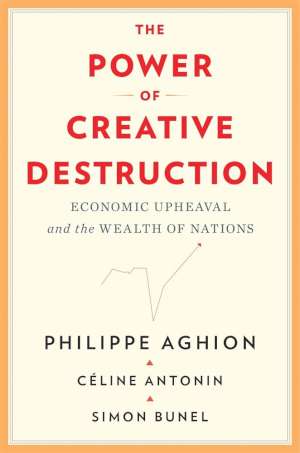15 July 2021
The Power of Creative Destruction:
Economic Upheaval and the Wealth of Nations
Philippe Aghion, Celine Antonin and Simon Bunel
2021, Harvard University Press, 416 pages,
ISBN 9780674971165
Reviewer: Bridget Rosewell

First, a shout out to the translator, Jodie Cohen-Tanugi. She’s a lawyer and a researcher into movement – but also capable of preparing an idiomatic and professional translation of economics. No doubt, Aghion, who also writes in English, could help but still this is a very readable and engaging text and credit needs to be given to the translator who provided it.
Second, this is a book about growth by economists which is grounded in empiricism as much as theory. Growth is, surprisingly, somehow a topic with which economists struggle. At one end there is the assumption of an exogenous technical progress added on to a production function and generating some neat equations which I once found quite fascinating. At the other, there is the challenge of complex systems analysis, with feedbacks and non-linearities which defy neat optimisation or stable solutions.
Although the seminal text in economics is Adam Smith’s ‘The Wealth of Nations’, which is part of the subtitle of this book, more recent economic paradigms have focused on economic management which seemed appropriate to the problems of the second half of the twentieth century. Even then, there were dissenting voices, of which Joseph Shumpeter, coining the term creative destruction in 1942, was one.
His ideas drew on different traditions and analytical approaches and form the focus for this book. Adding to this difference to much of the standard model, it is particularly fascinating to read a book where most of the examples are French, then spreading out into the US and other European countries. It provides an alternative perspective for British readers as a result and this itself is useful.
As the title suggests, the book expounds the role of creative destruction in economic growth and in enabling take-off. It also examines the downsides – as well as how to foster growth that improves living standards and health – looking at how to contain and manage the destruction which is the flipside of creation. There is an early recognition that destruction is uncomfortable and damages lives, but this is countered by its benefits and driving force. And so the book focuses on how to enable creative destruction, and then how to manage the fallout.
Unleashing the force requires reducing the power of the vested interest of incumbents and supporting research and development on a wide scale. Managing the force requires an active state with effective welfare policies and anti-trust legislation.
Some readers may be unnerved by the lack of references to production functions or total factor productivity. Some may feel that there should be some reference to comparative advantage. This is not a book which comes from that mode of thought and is all the better for a single-minded focus on the powerful force which Shumpeter called the most important fact about capitalism.
The authors clearly agree with this, and the book falls essentially into two halves. One is why and how creative destruction enabled the living standards we currently have and why it is still needed in a world where climate change is an existential problem and the most effective route to a more sustainable world.
The second half is about how to contain the destruction and how to enable continued innovation. This rests on how to improve the way markets, government and civil society can work together to manage externalities and improve collaboration and co-ordination. The authors argue that innovation needs democracy, and implicitly that democracy needs a functioning civil society. Your reviewer finds this argument convincing, back to the formation of the Royal Society in 1660, and the debates between Newton and Leibniz.
The authors draw on Phillipe Aghion’s immense body of work looking at the stylised facts of growth and the hypotheses that might explain them. It is an impressive study when pulled together in this way. It convinces, to my mind, on what the path to a better world, with less inequality, injustice, environmental catastrophe might look like. It is perhaps less convincing on whether we can achieve it. Indeed, in their conclusion they admit they might be accused of naïve optimism. They contrast the two models of capitalism as ‘cut-throat’ versus ‘cuddly’ and instance the USA as the former – which generates innovation – and Scandinavian countries as the latter – and less innovative. They ask whether instead of either/or whether it is possible to be both/and. They conclude that it is, but that it is up to us to make it happen.
